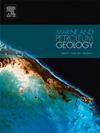Fracturing in basinal siliciclastic deposits of the Wolfcampian Alta Formation, Marfa Basin, west Texas
IF 3.7
2区 地球科学
Q1 GEOSCIENCES, MULTIDISCIPLINARY
引用次数: 0
Abstract
The Wolfcampian Alta Formation represents 1700 m of deep-water siliciclastic deposits exposed in the Marfa Basin, the southwestern sub-basin of the Permian Basin complex of west Texas. These exposures are important outcrop analogs for the highly productive Wolfcamp Shale oil and gas reservoir of the Delaware and Midland Basins because they are of similar age, lithologies, and depositional environments. We present preliminary field data from outcrops of the Alta Formation in the southeast part of the Chinati Mountains, including lithostratigraphy, fracture characterization, and mineralogical analyses. Mesostructural deformation fabrics are dominated by up to four systematic sets of bed-perpendicular opening- mode fractures but also include rare bed-parallel opening-mode veins (beef), and occasional normal faults and thrust faults. Opening-mode fractures are generally bed-restricted and are interpreted to record a complex history reflecting changing extension direction at the time of fracturing in these sandstone and shale strata. Fracture dimensions mapped in a sandstone bedding pavement exposure show that length (parallel to bedding) to height (perpendicular to bedding) ratios for opening-mode fractures range from 0.13 to 38.56, with an average aspect ratio for all mapped opening-mode fractures of 4.84. Scanline surveys of a systematic NE-striking opening-mode fracture set show that fracture spacing is strongly correlated with mineralogy in both sandstone and shale lithologies, with a strong positive correlation for fracture spacing vs. clay content, and very strong negative correlations for fracture spacing vs. quartz, quartz + feldspar, and brittleness index. Bed thickness vs. fracture spacing data from scanlines show marked differences between sandstone and shale beds, with a very strong positive correlation for sandstone beds, a weak negative correlation for shale beds, and a very weak positive correlation – i.e. no correlation – for combined data. These results suggest that composition exerts a first-order control on opening-mode fracture abundance, and that bed thickness is likely a subordinate, or less important, controlling factor. These relationships can potentially be leveraged for mineralogy-based subsurface fracture prediction in comparable siliciclastic deposits.
德克萨斯州西部Marfa盆地Wolfcampian Alta组盆地硅塑性沉积中的压裂
Wolfcampian Alta组是德克萨斯州西部二叠纪盆地西南次盆地Marfa盆地中1700米的深水硅屑沉积。这些暴露是Delaware和Midland盆地高产Wolfcamp页岩油气储层的重要露头类似物,因为它们具有相似的年龄、岩性和沉积环境。本文介绍了中国山脉东南部阿尔塔组露头的初步野外资料,包括岩石地层学、裂缝表征和矿物学分析。细观构造变形组构以多达4组系统的床面垂直张开型裂缝为主,但也有罕见的床面平行张开型脉(牛肉),偶有正断层和逆冲断层。开缝型裂缝通常受床层限制,并被解释为记录了复杂的历史,反映了这些砂岩和页岩地层在压裂时扩展方向的变化。在砂岩层理路面暴露中绘制的裂缝尺寸显示,裂缝的长度(平行于层理)与高度(垂直于层理)之比为0.13 ~ 38.56,所有绘制的裂缝的平均纵横比为4.84。对系统的ne向开口型裂缝组的扫描线调查表明,裂缝间距与砂岩和页岩岩性的矿物学有很强的相关性,裂缝间距与粘土含量呈正相关,裂缝间距与石英、石英+长石和脆性指数呈很强的负相关。扫描线的床层厚度与裂缝间距数据显示砂岩层和页岩层之间存在显著差异,砂岩层的正相关非常强,页岩层的负相关很弱,而组合数据的正相关非常弱,即没有相关性。这些结果表明,成分对张开模式裂缝丰度起一级控制作用,而层厚可能是次要的或不太重要的控制因素。这些关系可以潜在地用于基于矿物的地下裂缝预测,用于类似的硅质碎屑矿床。
本文章由计算机程序翻译,如有差异,请以英文原文为准。
求助全文
约1分钟内获得全文
求助全文
来源期刊

Marine and Petroleum Geology
地学-地球科学综合
CiteScore
8.80
自引率
14.30%
发文量
475
审稿时长
63 days
期刊介绍:
Marine and Petroleum Geology is the pre-eminent international forum for the exchange of multidisciplinary concepts, interpretations and techniques for all concerned with marine and petroleum geology in industry, government and academia. Rapid bimonthly publication allows early communications of papers or short communications to the geoscience community.
Marine and Petroleum Geology is essential reading for geologists, geophysicists and explorationists in industry, government and academia working in the following areas: marine geology; basin analysis and evaluation; organic geochemistry; reserve/resource estimation; seismic stratigraphy; thermal models of basic evolution; sedimentary geology; continental margins; geophysical interpretation; structural geology/tectonics; formation evaluation techniques; well logging.
 求助内容:
求助内容: 应助结果提醒方式:
应助结果提醒方式:


